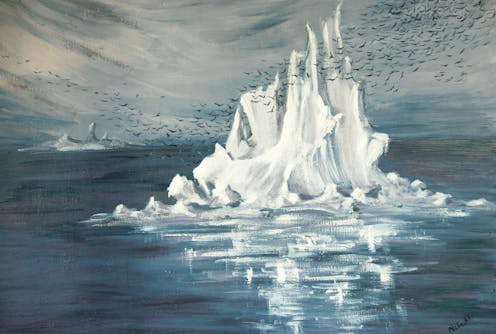Nel Law stowed away on her husband’s ship to Antarctica. She was the first Australian woman to see its ‘crystalline strangeness’
- Written by Edwina Preston, PhD Candidate, The University of Melbourne

I know many people born in 1961 – they are my contemporaries and friends. It doesn’t seem so long ago. Their lives and experiences seem modern to me. They don’t seem old: certainly, none of them have problems working their iPhones. And yet, 60 years is aeons ago when it comes to feminism and gender relations.
In 1961, a woman might be barred from a university position post-marriage if unable to show medical evidence of a hysterectomy. A gay man was coyly, whisperingly, described as a “friend of Dorothy” (and might lose his job if word got out). And a stunned albatross on a ship’s deck was far less of an ill omen than the insulting presence of a woman on board an expedition to Antarctica[1].
Rachael Mead’s novel, The Art of Breaking Ice[2], imagines several months across 1960–1961, when pioneering Melbourne artist Nel Law stowed away on her explorer husband’s 13th voyage to Antarctica (albeit with his permission). She became not only the first artist in residence on an expedition, but the first Australian woman to step foot on Antarctica.
Review: The Art of Breaking Ice – Rachael Mead (Affirm Press)
Nel’s life as a 1960s Camberwell housewife and a talented, though not professional, artist is one in which the activities and ardours and endeavours of a woman are never worthy of the word “work”. (That word is quarantined for the use of men.)
We meet Nel deep in preparation for one of her husband’s “Antarctic-themed” pre-expedition dinner parties: slaving in the kitchen to produce a gustatorily repellent menu of penguins on horseback and seal liver pastries.
Nel is, foremost, her husband’s wife – agreeably giving up the chance of children because it doesn’t suit her husband’s schedule, disproportionately grieving over the loss of a compensatory cat. And going through “the change” in an era when such things as hot flushes are assiduously disguised, and sanitary products must be washed, wrung out and dried without ever being glimpsed by a member of the male sex. Nel, an “abstract” landscapist, is secretly turning from “oil to watercolour” inside.
The wife of a visiting dinner guest, however, is also a professional art critic. And when she spies Nel’s work on the living room walls, she gives her the courage to imagine what she might be capable of painting. Not from secondary artefacts – her husband’s photographs of Antarctica – but from being in Antarctica herself, painting en plein (if crystal-cold) air.
And so: the stowaway occurs, with a tacit nod from a few institutional VIPs.
Read more: 'No woman could paint': The Story of Art Without Men corrects nearly 600 years of male-focused art criticism[3]
An artist’s tools
Mead demonstrates a formidable knowledge of the Antarctic circle (she has travelled there twice), the machinations of an Antarctic expedition and the realities and rituals of a brutally masculine 1960s ship voyage. Not to mention the tools of an artist: the advantages, nuances and limitations of oil, watercolour, charcoal, pencil.
But it is the human drama of a lone female trapped for several months in a hostile world “meant for men” that makes this novel tick and hum and, dare I say it, throb.
“Why should this place be only for them?” Nel asks the four necessarily “unattached” female fieldworkers who accompany her for part of the voyage. Yet it clearly is.
Nel proceeds on the voyage as invisibly, as benignly, as she can: amid misogynist mutterings, sexual rumours, condescending takedowns and blatant intimidations. To her deep pain, it is not only the crew and male researchers who are her antagonists, but increasingly, her husband himself.
He reveals himself to be both petulantly, ferociously ambitious, and hard on his comrades – he is known among the crew as “Antarctic Stalin”.
The novel evokes the drama of Nel Law (featured here) as a lone female in a world ‘meant for men’.Between navigating the men on board, deploying her artistic skills to men’s research purposes, and managing the myriad menopausal symptoms that imperil her composure, Nel must also sustain the placatory reflex of being wife to a difficult man. “It was a habit, this vigilance – a continual scanning of his emotional temperature, assessing what he needed, calibrating her response.”
Certainly, in 2023, I know this reflex in my own relationships with men – it is not confined to women of the 1960s.
Read more: 'Suburban living did turn women into robots': why feminist horror novel The Stepford Wives is still relevant, 50 years on[4]
Marriage’s choppy waters
Mead has published four poetry collections, and her poetic talents serve her well in describing the indescribable. The spectacle of Antarctica, which appears on a map “like a huge albino tadpole”, but is something vividly other in the flesh – with its mysterious ice and landscapes, the crystalline strangeness of a floating berg, the reek of penguin guano.
And the subtly coloured flesh of the Adelies penguins[5] she illustrates for her ornithologist friend, Harris – perhaps the only man on board who sees her as a person and artist in her own right, not the private property of her husband, or an interloper.
The Art of Breaking Ice is the dramatisation of a true story – Mead makes this clear in her author’s note – but it is also the reimagining of stories that remain untold.
The novel is book-ended by contemporary fragments, like a commemorative service for Phil and Nel Law, in which pioneering explorer Phil Law, “Man of Antarctica”, is lionised, and his wife is, well, mentioned.
Nel’s voyage to Antarctica and back, through the choppy and frequently icy waters of a longstanding marriage, is the story of a woman’s right to be, to change, to grow and to love. Mead beautifully tracks Nel’s transition from being an interesting appurtenance to a man’s life, to an interesting woman in her own right.
References
- ^ Antarctica (theconversation.com)
- ^ The Art of Breaking Ice (affirmpress.com.au)
- ^ 'No woman could paint': The Story of Art Without Men corrects nearly 600 years of male-focused art criticism (theconversation.com)
- ^ 'Suburban living did turn women into robots': why feminist horror novel The Stepford Wives is still relevant, 50 years on (theconversation.com)
- ^ Adelies penguins (theconversation.com)
















